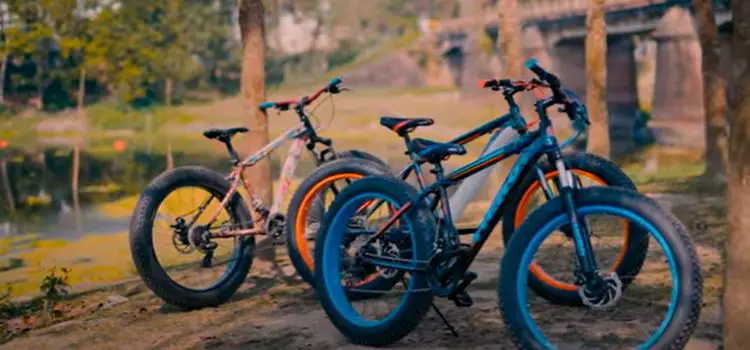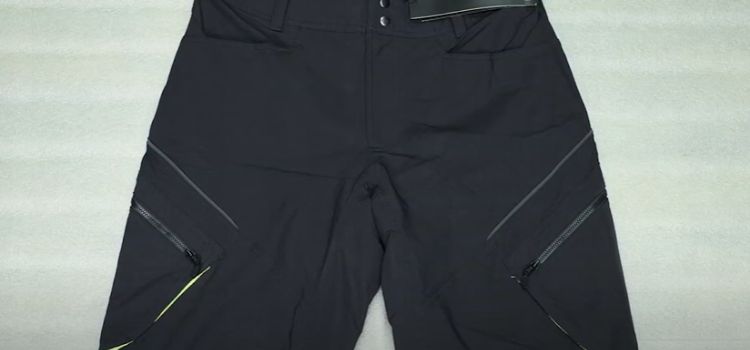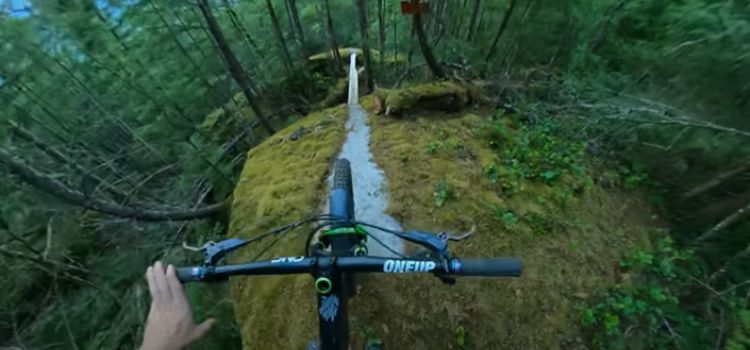Mountain Bike vs. Fat Bike: A Detailed Comparison!
As an Amazon Associate I earn from qualifying purchases.
In the world of off-road cycling, the choice between a mountain bike and a fat bike can significantly impact your riding experience. Both designed for rugged terrain, these bikes cater to different preferences and purposes.
In this comprehensive guide, we will delve into the distinctive features of mountain bikes and fat bikes, exploring their design, components, and applications to help you make an informed decision when venturing into the exhilarating world of off-road cycling.

Evolution and Origins
To understand the nuances of mountain bikes and fat bikes, it’s essential to explore their origins. Mountain bikes first emerged in the late 1970s, designed to tackle challenging off-road terrain with wider tires compared to traditional road bikes.
On the other hand, fat bikes, also known as fat tire bikes, gained popularity in the late 1980s with the introduction of modern fat bikes designed for softer surfaces like snow, sand, gravel, and mud.
Tires: The Foundation of Distinction
One of the most noticeable differences between mountain bikes and fat bikes lies in their tires. Fat bike tires are notably wider, typically ranging from 3.8 to 5.2 inches, compared to the 1.9 to 2.6-inch width of mountain bike tires. The width of fat bike tires allows them to navigate soft terrain with ease, preventing sinking in snow or sand. The lower tire pressure (5 to 14 PSI) further aids in weight distribution, making fat bikes suitable for a forgiving and comfortable ride.
Mountain bike tires, while wider than those on road bikes, are narrower than fat bike tires. Designed for versatile off-road use, they provide the necessary grip for navigating rocky trails and challenging terrains. The tire pressure for mountain bikes generally ranges from 22 to 35 PSI, contributing to a more responsive ride over varied surfaces.
Frame Design: Adapting to the Terrain
The frame design of a bicycle is a critical element that significantly influences its performance and adaptability to various terrains. When it comes to mountain bikes and fat bikes, their frame designs are tailored to meet the unique demands of off-road cycling, each offering distinct advantages based on the intended use and terrain characteristics.
Mountain Bike Frame Design
Mountain bike frames are crafted with a focus on versatility, durability, and maneuverability. The frame is typically made from materials such as aluminum, carbon fiber, or steel, each offering its own set of characteristics. The design of a mountain bike frame takes into consideration the challenging terrain it is expected to traverse.
1. Geometry
Aggressive vs. Relaxed Geometry: Mountain bikes can have different geometries, ranging from aggressive to relaxed. Aggressive geometry, with a steeper head angle and shorter wheelbase, enhances maneuverability and responsiveness, making it ideal for technical descents and tight corners. On the other hand, relaxed geometry provides stability and comfort, making it suitable for longer rides and varied terrains.
2. Suspension Systems
Full Suspension vs. Hardtail: Mountain bikes often feature suspension systems to absorb shocks and enhance traction. Full-suspension bikes have both front and rear suspension, providing a smoother ride on rough terrain. Hardtail bikes, with only front suspension, are lighter and more efficient for climbing but may transmit more vibrations to the rider.
3. Tire Clearance
Accommodating Wider Tires: Mountain bike frames are designed to accommodate wider tires, providing better traction on loose surfaces. This tire clearance allows riders to customize their setups based on the specific demands of the trail.
4. Durable Construction
Materials and Build Quality: The materials used in mountain bike frames are chosen for their durability and strength. Aluminum frames are lightweight and corrosion-resistant; carbon fiber frames offer a balance of strength and weight; and steel frames provide durability and a smooth ride.
Fat Bike Frame Design
Fat bikes, designed for specialized terrains like snow, sand, and mud, have frame designs that cater to the unique requirements of these surfaces.
1. Wider Frame Dimensions
Accommodating Fat Tires: The most distinctive feature of a fat bike frame is its wider dimensions. This is necessary to accommodate the extra-wide fat tires, ranging from 3.8 to 5.2 inches. The frame includes wider seat stays, chain stays, and forks, allowing sufficient space for the massive tires.
2. Enhanced Stability
Wide Base for Soft Surfaces: Fat bikes are built for stability on soft surfaces like snow and sand. The wider frame provides a solid base, preventing the bike from sinking into these softer terrains.
3. Limited Suspension Systems
Minimal Suspension Components: Unlike many mountain bikes, fat bikes often have minimal or no suspension systems. The wide, low-pressure fat tires inherently act as shock absorbers, providing a cushioning effect. This lack of suspension contributes to a simpler design and reduced maintenance.
4. Specialized Builds
Snow and Sand Adaptations: Some fat bikes come with specific features such as wider bottom brackets and special drivetrain configurations to optimize performance in snowy or sandy conditions. These adaptations contribute to better traction and efficiency.
Suspension Systems: Navigating Bumps and Drops
Suspension plays a pivotal role in off-road biking, providing control and comfort in challenging terrain. Mountain bikes often come equipped with suspension systems, either in the front, rear, or both. “Hard tail” mountain bikes lack rear suspension, while “soft tail” models include it. These suspension systems enhance grip on the terrain and absorb shocks, contributing to a smoother ride.
Fat bikes, designed for softer surfaces, often forego suspension systems due to the cushioning effect provided by their wide tires. The absence of suspension contributes to a slower handling experience, which aligns with the need for stability when traversing snow or sand without sudden directional changes.
Hubs and Pedals—Unseen Yet Impactful
While less noticeable, differences in hub size and pedal alignment contribute to the unique characteristics of mountain bikes and fat bikes. The hub, the central part of the wheel attaching it to the bike frame, must accommodate the tire width. Fat bike hubs are wider, ranging from 170 to 190 mm, to match the width of fat bike tires. In contrast, mountain bike hubs can afford to be thinner due to the narrower tires.
The pedal alignment, known as the Q factor, affects the distance between pedals. Fat bikes, with their wider frame and tire width, often have a larger Q factor, causing the pedals to be farther apart. This distinction may lead to potential discomfort in the knees and hips over extended rides.
Brakes: Ensuring Reliable Stopping Power
Both mountain bikes and fat bikes typically feature disc brakes, offering superior stopping power, especially in adverse conditions. Disc brakes also allow for the accommodation of wider tires compared to traditional rim brakes. Reliable braking systems contribute to rider safety and control, crucial elements when navigating unpredictable off-road terrain.
Riding Experience: Choosing Your Adventure
The choice between a mountain bike and a fat bike ultimately depends on the type of riding experience you seek. Fat bikes excel on soft surfaces like snow, sand, loose gravel, and mud. The wide, soft tires provide extra traction and forgiveness, making fat bikes an excellent choice for beginners exploring off-road cycling. However, the trade-off is reduced speed and increased effort required for pedaling due to higher rolling resistance, bike weight, and fewer gears for speed.
Mountain bikes, with their wider yet less bulky tires, are designed for a broader range of off-road terrain, including rocky trails, roots, and challenging descents. The suspension systems on many mountain bikes enhance control, absorb shocks, and allow for quick changes in direction, making them suitable for more aggressive off-road riding.
Comparing Specifications Of Fat Bike and Mountain Bike: A Detailed Analysis
To provide a more granular understanding, let’s compare some detailed specifications and statistics for fat bikes and mountain bikes:
| Aspect | Fat Bike | Mountain Bike |
|---|---|---|
| Tire Width | 3.8–5.2 inches | 1.9-2.6 inches |
| Tire Pressure | 5 to 14 PSI | 22–35 PSI |
| Suspension | None | Front and/or rear on some models |
| Weight | 33 to 36 pounds | 28 to 34 pounds |
| Handlebars | Flat bar | Flat bar |
| Hubs | 170–190 mm | 142 mm |
| Q Factor | 200mm | 170mm |
Cost Considerations: Budgeting for Adventure
The cost difference between fat bikes and mountain bikes reflects their popularity and niche appeal. Mountain bikes, being more mainstream, offer a wide range of options, from budget-friendly to high-end models. Brands like Specialized and Canyon provide a variety of mountain bikes with prices ranging from $700 to over $10,000, depending on the frame material and components.
Fat bikes, being more niche, may have a more limited selection from well-known manufacturers. The Giant Yukon and Trek Farley, among the most popular fat bikes, are priced around $2100 and $2600, respectively. Smaller niche makers like Surly and Salsa also contribute to the fat bike market with unique offerings.
It’s worth noting that while low-budget options exist for both fat bikes and mountain bikes, investing a bit more can result in a bike with better durability and performance. Ultimately, the chosen budget should align with the rider’s preferences, skill level, and long-term commitment to off-road cycling.
Conclusion: Choosing Your Adventure Companion
In conclusion, the choice between a mountain bike and a fat bike hinges on your preferred riding experience and the terrain you plan to conquer. If you seek the thrill of speeding down challenging trails, navigating rock gardens, and conquering cross-country terrain, a mountain bike is the ideal companion.
On the other hand, if your adventures lead you through soft surfaces like snow or sand, a fat bike with its forgiving, wide tires is the perfect choice.
For those torn between the two, why not explore both worlds? Having both a mountain bike and a fat bike allows riders to enjoy the best of both terrains, ensuring a versatile and fulfilling off-road cycling experience.
Whether you opt for the speed and agility of a mountain bike or the stability and traction of a fat bike, the world of off-road cycling awaits, ready to offer exhilarating adventures and unforgettable memories. Choose your adventure companion wisely, and let the trails be your guide.
Amazon and the Amazon logo are trademarks of Amazon.com, Inc, or its affiliates.






